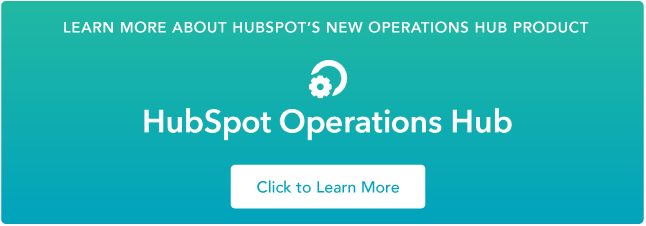In the 80s, databases were created in order to make data accessible and manageable — but with this creation came challenges around collecting, storing, securing, and deleting data. Over time, data and IT experts have theorized and shared best practices to provide a model known as Data Lifecycle Management (DLM).

Understanding the principles of DLM can help any business — from enterprises to small- and medium-sized businesses — establish a structure for their data to flow through, or refresh an existing one. Let's dive into this topic below.
Learn More About HubSpot's Operations Hub Software
What is Data Lifecycle Management?
Data Lifecycle Management (DLM) is a model for managing data throughout its lifecycle so it’s optimized from creation to deletion. DLM is broken down into stages that typically begin with data collection and end with data destruction or re-use.
By defining, organizing, and creating policies around how data should be managed at every stage of its life, DLM helps you get the most out of your data up until the point that it's deleted.
What are the three main goals of data lifecycle management (DLM)?
While there are countless benefits of DLM, there are three main goals of this model. Let's take a closer look at them below.
Security
A main goal of Data Lifecycle Management is keeping your data secure. By creating protocols for managing data from the time it’s created to the time it’s deleted, you are helping to prevent that data from being accessed by threat actors and other unauthorized users or being corrupted by malware and other infections.
Availability
While one goal of DLM is to make sure data is not accessible to certain users, an equally important goal is to ensure that data is available to the right users at the right time. If it isn’t, then multiple processes and workflows could be interrupted or fail.
Integrity
Another goal of DLM is to maintain data integrity meaning that only the most up-to-date and high-quality data is created and store in your database. Without DLM, users could access, use, and store outdated or different versions of data.
Data Lifecycle Management vs Information Lifecycle Management
There are lots of parallel or complementary models to DLM that can guide you through the countless challenges of data management.
For example, DLM often overlaps with Information Lifecycle Management (ILM). The main difference between the two concepts is that, while DLM determines when a piece of data ends its useful life, ILM regulates when a piece of information is relevant and accurate and how to store it accordingly.
Despite the number of parallel or complementary models, the DLM framework has become a prototype for its simplicity and efficiency. Let's define this framework below.
Data Lifecycle Management Framework
Since each company has its own business model, software stack, and types of data, there are lots of variations on the DLM framework.
When researching online, you'll notice that the number of stages and words used to describe each stage differ. For instance, the first stage may be referred to as data collection, acquisition, capture, or creation, depending on how a company's data becomes part of the database.
While every company should adjust the DLM framework to its own technology ecosystem, there are five general stages, as illustrated below.
1. Data collection
Data collection refers to the stage of DLM where a new value enters your company's data infrastructure. It can be either hardware or software. For this phase, you must establish a set of rules to gather data in standardized formats so it can be accessible and manageable later on.
Those rules or policies must be adequate to each type of data collected. So you should specify policies for employee data, partner data, accounting, etc. For personal data in each category, you must also take into account applicable data privacy regulations.
During data collection, you can start using initial categories such as "sensitive data," "internal data," or any other label that helps you decide how to manage or process data in the further stages.
2. Data Storage
Data storage best practices depend on its use. Collected data can become an active asset and be used or reused, or it can become inactive and be archived or deleted. In either scenario, you need to establish policies around its storage. Backup and recovery options are also important to keep in mind.
As an example of these policies, you could stipulate that inactive data that may be relevant in the future be stored in a cold storage environment (which would help reduce costs).
3. Data Maintenance
The data maintenance stage covers several processes, including inspecting and enriching data before making it accessible to the right users.
The general goal in this phase of DLM is to make sure that relevant data is available for the right team when and where they need it. So after validating and enriching the data, you'll need to move it to the right place. That's where data integration comes in.
Data integration is perhaps the most complex and important part of data maintenance. In some cases, you can use a native or in-app integration solution. If that's not available for your apps, you'll need an Integration Platform as a Service (iPaaS) or another third-party solution.
Some companies, especially for accounting and investment decisions, add another step after this one called data synthesis.
When your database is growing, ongoing CRM data maintenance is necessary to ensure that the data is usable for sales and marketing initiatives. Without continuous maintenance, you’ll find that data quality issues can quickly balloon, impacting anyone who relies on customer data within your organization.
4. Data Usage
This is where data will play a role in business decisions. During the previous stages, data was collected, organized, inspected, and moved to the right platform. At this point, it must be easy for administrators or stakeholders to locate this data and make decisions based on the information it reveals.
Part of this stage is data publication. Establishing protocols for data publication is important, especially for companies that share information outside the business environment. An example of data publication policies could be a set of rules for sharing reports with partners or clients.
5. Data Cleaning
The stage of data cleaning includes deletion, purging, destruction, and archiving. Your data is growing every day and storing it is quite expensive. That's why when data is no longer useful, it's a good idea to delete it or purge it from your databases.
For inactive data that might be useful in the future, you can also create policies on how to archive it or separate it from the active data.
All policies around disposal are part of the data cleaning stage.
To learn more about data cleaning and the other stages in DLM, check out this video by Projerra:
Benefits of Data Lifecycle Management for Enterprises
Just keeping the stages of DLM in mind can help you visualize the journey of data through your company in order to build a plan to manage data. Implementing a DLM framework can provide additional benefits, like:
- Helping you comply with the regulations and requirements for data retention. Each industry has its own regulation regarding data. There are also local or regional laws to protect personal data that may apply.
- Guaranteeing efficiency. You'll have access to relevant information at the right time. When you implement DLM, you'll set the standards to automate the validation, enrichment, and integration of data.
- Offering security. Across all the stages, you are considering the most secure ways to manage data. For data storage, you also create contingency plans in the event of an emergency.
- Increasing the value of your data. Having quality data — and ensuring its integrity — makes data a much more valuable asset for your company.
How can Data Lifecycle Management help small businesses?
In general, the benefits of DLM can also apply to smaller businesses. Creating and implementing all these policies and automation processes may seem excessive if you're running a very small business. However, it's never too early to consider the DLM stages and come up with a data management plan that can grow with your company.
On a smaller scale, you can consider taking the following actions for the different stages of DLM:
- For data collection: Use web forms on relevant content.
- For data storage: Place inactive or internal data in cloud-based storage services.
- For data maintenance: Use iPaaS tools or integration platforms.
- For data usage: Create documentation to help stakeholders locate data.
- For data cleaning: Establish a periodic process to delete unnecessary data.
Getting Started with DLM
As your business grows, the size and complexity of your data will also increase. Regardless of your business size or the IT infrastructure you manage, creating a structure based on DLM allows you to visualize the entire journey of your data across the organization.
Having a full picture of your business data helps you to identify vulnerable points where policies are necessary to keep your data safe. At the same time, it empowers you to get the most out of your data to make informed decisions for your business.


